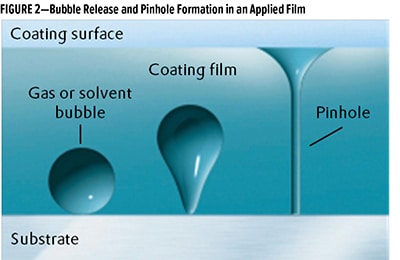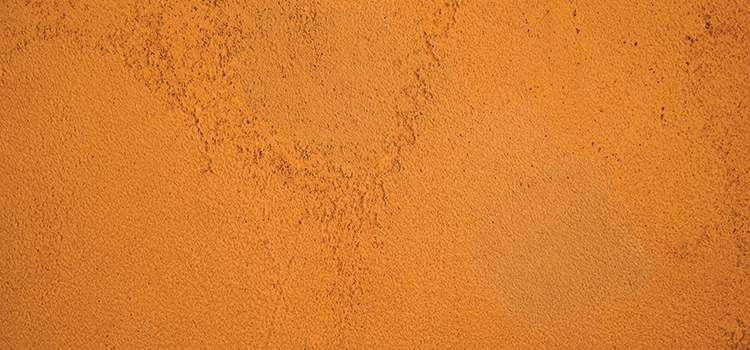By Jim Reader, Jos van Oosterwijk, Caixuan Xu, Ye Dai, Ruediger Mertsch, Shauna McAuliffe, and Jianchang Tang, Evonik Corporation
Pinholes are a problem for formulators developing fast-drying, water-based coatings, especially in coatings cured at high temperature and applied at high wet film thickness. Pinholes are often caused by air or solvent vapor release from the film when the coating is too viscous to flow back and repair the holes. Pinholes also occur in baked coatings, as the trapped vapor regains mobility when the coating softens under heating, before crosslinking hardens the film, preventing flow back into the voids.
Hydrocarbon-based defoamers help eliminate the foam and pinholes in these formulations, but their limited compatibility results in lower gloss, poor leveling and surface appearance. This paper describes a new additive that combines both deaeration of microfoam and modified surface drying for pinhole elimination. This new additive shows comparable pinhole elimination compared with hydrocarbon-based defoamers, but without compromising formulation compatibility or final coating appearance.
INTRODUCTION
 Pinholing has been described as “the formation of minute holes in the wet film of a coating material that form during application and drying, due to air or gas bubbles in the wet film that burst, giving rise to small craters that fail to coalesce before the film has set.”1 These tiny defects disrupt the surface appearance, especially in high gloss formulations, and reduce the protective properties of the finished coating. Pinholes are a problem for both water-based and solvent-based coatings although the cause of the defect may be different. They are also frequently seen in oven-cured coatings when the defect may not appear until the coating is baked. The effect can be seen in Figure 1, which shows the cured surface of a black, solvent-based, automotive OEM basecoat where the coating film thickness increases from left to right.
Pinholing has been described as “the formation of minute holes in the wet film of a coating material that form during application and drying, due to air or gas bubbles in the wet film that burst, giving rise to small craters that fail to coalesce before the film has set.”1 These tiny defects disrupt the surface appearance, especially in high gloss formulations, and reduce the protective properties of the finished coating. Pinholes are a problem for both water-based and solvent-based coatings although the cause of the defect may be different. They are also frequently seen in oven-cured coatings when the defect may not appear until the coating is baked. The effect can be seen in Figure 1, which shows the cured surface of a black, solvent-based, automotive OEM basecoat where the coating film thickness increases from left to right.
The most common cause of pinholes is the release of volatile materials or trapped air from the drying film after application. These gases form bubbles in the film that move to the coating-air interface, driven by buoyancy forces or surface-tension-driven flow.2 The movement of the bubble will be slowed by the increasing viscosity of the paint film, and a pinhole is formed when the coating cannot reflow to fill the void left behind by the escaping bubble (Figure 2).  Bubbles may also remain trapped in the dry film but regain mobility when the coating is heated and softens before crosslinking. As the coating cures, viscosity rebuilds that prevents flow back into the voids. The gas pressure may also be enough to blow through a dry-coating film, either the original primer or a topcoat, in a multilayer application. This can also create pops, craters, and other effects. The defect can also be caused by air or gases released from the substrate (e.g., wood) or even absorbed by the substrate and released on heating.3
Bubbles may also remain trapped in the dry film but regain mobility when the coating is heated and softens before crosslinking. As the coating cures, viscosity rebuilds that prevents flow back into the voids. The gas pressure may also be enough to blow through a dry-coating film, either the original primer or a topcoat, in a multilayer application. This can also create pops, craters, and other effects. The defect can also be caused by air or gases released from the substrate (e.g., wood) or even absorbed by the substrate and released on heating.3
There are several ways to reduce or prevent pinholes (e.g. reducing the coating’s film thickness, using slow (co)-solvents), although the mechanisms for bubble release from a film are not fully understood and remain subject for considerable research.2-7 The reduced film thickness reduces the amount of gas and volatiles present, as well as the distance and time needed for the bubbles to escape. Slow (co)-solvents delay the drying of the film and may also slow the buildup of viscosity, again allowing more time for the bubbles to escape. Reducing film thickness may result in insufficient hiding and protection or require multiple applications to achieve the required total film thickness, which may also lead to pinholes. Changing the (co)-solvent package can affect drying properties and conditions but may also not be possible within regulated VOC (Volatile Organic Component) limits or local environmental regulations.
Defoamers and antifoams are also used to control pinholes, although these additives can cause other problems, such as craters, fisheyes or poorer substrate adhesion, and/or intercoat adhesion.8-9 Defoamers can also influence gloss, orange peel, and depth of image—critical properties in automotive coatings.10 Therefore, careful defoamer selection is required when choosing additives for pinhole control in such coatings.
